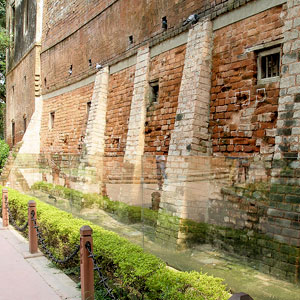What to See
Jallianwala Bagh: This historical site commemorates one of the most gruesome acts of mass killing committed by the British during India’s struggle for independence. Today it has been converted to a beautiful park and the Martyr’s Gallery Museum. The well, where people jumped to escape death is also a protected monument within. Two memorials have been erected here – one a tear-shaped structure and the other an eternal flame.
Open from: Martyr's Gallery – 9.00 am-5.00 pm in summers; 10.00 am-4.00 pm in winters
Ram Bagh: This was once the summer palace of Maharaja Ranjit Singh and is created in a pattern similar to the Shalimar Bagh in Lahore. This garden is named after the founder of Amritsar, Guru Ram Dass and houses a huge statue of the Maharaja seated on his horse. Also located within the garden is a Museum, which has on display weapons, images of governing houses of Punjab and a replica of the famous Kohinoor Diamond.
Open from: Museum – 10.00 am-5.00 pm, Mondays closed

Golden Temple: Also called Harmandir Sahib, this is the most revered Sikh pilgrimage site, visited by countless tourists all year through. Located centrally in Amritsar, this structure is built in marble and is half-covered in real gold, which sparkles brilliantly when the rays of the sun touch it. The temple is situated in the middle of the Amrit Sarovar or the Holy Pool of Nectar and is accessible by clean marble walkways and pavements. The temple is open to all visitors, irrespective of religion – the only condition being that meat, alcohol and cigarettes are strictly prohibited in the complex. You must remove your shoes and cover your head before entering the temple and wash your feet in a shallow pool. The temple is reached by the marble walkway or Guru’s Bridge, which is especially beautiful because of the silver-door Darshini Deorhi, by following the parikrama or clockwise direction. The Hari Mandir is the most sacred part of the temple and is the gold-covered building with copper carvings and white marble walls encrusted with precious stones in a floral pattern. The entire structure is covered with verses from the Guru Granth Sahib. Once inside the Hari Mandir, you would find devotees immersed in prayers, as devotional songs are sung and scriptures from the holy book are read beneath a jewel-encrusted canopy. The book is fanned by a chauri and devotees pay respects by touching their heads to the temple floor and walls. Every night the royal procession takes place along the Guru’s Bridge, when the Guru Granth Sahib is carried to the gold-plated five-floored Akal Takht or Eternal Throne, seat of Sikh Parliament. It also houses a Museum, which has images and memorabilia of Sikh Gurus and warriors. Also located within are several smaller shrines as well as an old jujube tree called the Ber Baba Buddha. An interesting feature of the temple complex is the Guru ka Langar, a dining hall, which actually feeds around 35000 people daily!
Open from: 7.00 am-8.00 pm in summer and 7.00 am-7.00 pm in winter
Note - The closing procession takes place at 11.00 pm in summer & 9.30 pm in winter
Durgiana Mandir: Truly one of the most beautiful temples in Amritsar, it is dedicated to Goddess Durga. Easily accessible from the Golden Temple, the temple is situated in the midst of a lake and is marked by a dome. The temple is also known as Lakshmi Narayana Temple and idols of Lakshmi, Vishnu, Radha Krishna, Sita and Ram adorn the walls. Other temples within the complex are Shivji Mandir, Bhairon Mandir and Hanuman Mandir, all of which hold interesting festivals including Janamashtami and Diwali.
Baba Atal Rai Tower: Named after the son of Guru Har Gobind, this nine-storied building is an important landmark in Amritsar. It is one of the tallest structures of Amritsar and has walls adorned with miniatures from the Guru’s life. This is also the best place to catch spectacular glimpses of the city.
Gurudwaras: Together with the Golden Temple, there are several other gurudwaras that dot the landscape of the town. Among these are Gurudwara Lohagarh and Gurudwara Dera Baba Nanak, which has a copper-gilded throne and a canopy of white marble. The Gurudwara Khadur Sahib is built in white marble and is situated on a raised platform. Goindwal Sahib was constructed by Guru Amar Das Ji and has an 84-step baoli. Gurudwara Chheharta Sahib is known for the 6-wheeled well in the complex. Gurudwara Manji Sahib is located on the banks of Sarivar Ramsar and is dedicated to the fifth Sikh Guru.
Wagah Border: Located 28 km from Amritsar, this is the international border between India and Pakistan. Busloads of visitors travel here from Amritsar for the spectacular Beating Retreat Ceremony, which is essentially a change of guards and flag hoisting ceremony.
Tarn Taran: This is a much-visited site owing to the popular belief that the tank here has amazing curative powers. The Gurudwara here was built by Guru Arjan Dev in memory of Guru Ram Dass.
Harike Bird Sanctuary: Located almost 40 km from Amritsar, Harike is one of the finest virgin bird sanctuaries in the country. It is sited at the confluence of Beas and Sutlej and is home to a host of migratory birds as well as several species of wild animals.
Top Hotels in Amritsar
- Ramada Amritsar
- Country Inn Suites By Carlson Amritsar
- Hyatt Amritsar
- Radisson Blu Hotel Amritsar
- Golden Tulip Amritsar
Top Landmarks in Amritsar
- Hotels Near Radha Soami Beas Satsang
- Hotels Near Amritsar Railway Station
- Hotels Near Amritsar International Airport
- Hotels Near Holy Harmandir Sahib
- Hotels Near Guru Ram Das Sarai






